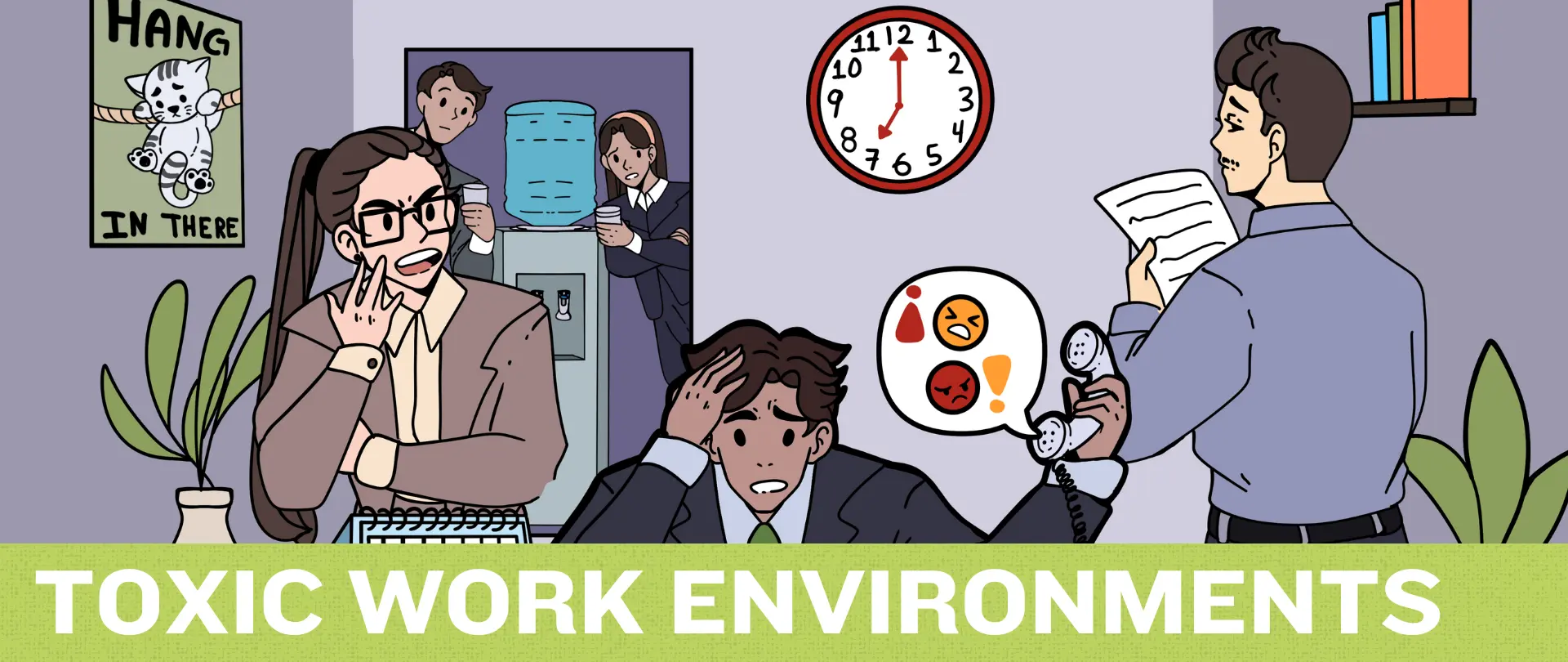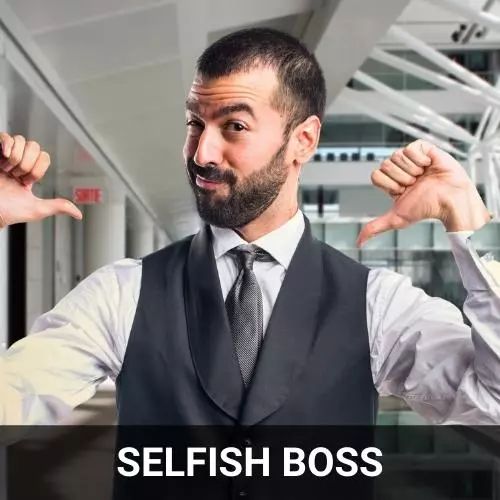Toxic Teams
You wake up Tuesday morning and immediately get that heavy, sinking feeling in your gut.
You know you have a team meeting today, and you know it’s going to be another disaster. All morning, you’ll be distracted by the stress of anticipation – who’s going to attack you this time? All afternoon, you’ll be replaying the worst bits of the conversation in your head.
Or maybe it’s Wednesday morning and you get an email from that person on your team who always manages to push your buttons. “I read your report and I found a few errors – can we talk at 3:00 about how to fix them before we show it to the boss?” Great. Now 3 p.m. looms like doomsday. Just when you thought today would be easy, here comes Mr. Know-it-all with his special brand of “help.”
Imagine it’s Friday afternoon. You’re wrapping up a few things and starting to feel ready for the weekend, when your boss calls you in to talk about the proposal you presented at the meeting on Thursday. She says some colleagues have raised questions to her about the strategy you outlined. Funny, you think to yourself, everybody said they were on board yesterday! Now you’ll be fuming about this all weekend.
If you work on a team, you have probably had one of these experiences – or something similar. If you think back over the teams you’ve been a part of, I hope you have been a member of at least one great team. If you have, then you’ve experienced the productivity and the pleasure of what teams can offer. Unfortunately, it might be easier to recall one or more awful teams on which you’ve worked. Maybe it was impossible to get along with your teammates. Perhaps, the team lacked a clear mandate and spent hours getting nowhere. There are so many ways a team can go wrong.
Sometimes the results of team dysfunction are relatively innocuous. The team might just be a little slower or a little less rewarding than you would like. But in too many teams, the problems are more severe. People find themselves dreading a job they used to enjoy because their teammates are bickering, or rejecting new ideas, or simply not pulling their weight.
Let’s be honest: Some teams are toxic.
One of the team effectiveness processes I use in my work is called the “Team Inoculation,” which we affectionately refer to as the “flu shot for teams.” Several years ago, I got a call from the CEO of a small financial organization who said, “I read your material about the flu shot for teams, and I’m wondering: Do you have a rabies shot for teams?”
I didn’t quite know what this CEO meant until I had a chance to work with his team. Within moments of walking into our first off-site meeting, I realized nobody was making eye contact. They’d look up at me – briefly – and look back down. I’ve seen plenty of teams that had trouble communicating, but these people couldn’t even look at each other.
Every person on that team was uncomfortable, frustrated, even wounded. But the problem went far beyond hurt feelings. On their company-wide employee survey, absolutely nobody agreed with the statement, “This organization has the leadership it needs to be effective.” Not one person, including the members of the executive team themselves. And don’t think these kinds of interpersonal problems don’t matter to the bottom line: Sales at this organization had been declining for three straight years.
That kind of deep dysfunction doesn’t appear overnight. In a way, the unhealthy state of so many workplace teams mirrors the chronic illnesses in our society – both are the result of failing to do some simple, small things every day to maintain health. None of those individual steps seems terribly important on its own. It’s no big deal if I skip my workout today – and the world won’t end if I don’t contribute much at the meeting this week. But eventually, missing all of those small steps adds up to a big problem.
For individuals, it can mean diabetes or heart disease. For teams, it can mean turning into one of the five types of diseased teams I’ll describe here. And in both cases, once the problem is really serious, it takes a lot of time and energy to put things right.
A healthy team needs two basic things: First, team members need to bring diverse talents and perspectives into alignment around the unique value they can add for the organization. Second, they need to trust each other enough to engage in productive conflict.
Without alignment, teams squander energy and accomplish little of value to the organization and the customer. And without trust, teams will get tangled up in interpersonal conflict – either out in the open or passively disguised. If these problems aren’t addressed, they can lead to a team that desperately needs help.
I’ve been researching and working to repair team dynamics for more than 15 years now. I’ve worked with teams from a wide range of industries, and I’ve tackled a lot of different problems. But I’ve noticed some common themes. I refer to them as the five diseases of teams.
It’s possible that your team has a full-blown case of one of these diseases – that the level of toxicity is obvious to all. But maybe you are only starting to see the tell-tale signs that a problem is brewing. Or maybe your team meetings feel pretty good and it won’t be until you read about the less obvious dysfunctions that you’ll become concerned.
There are five types of toxic teams that I’ve seen come up over and over again.
IN THIS EDITION:
Toxic Team Diagnostic
Crisis Junkies
I once worked with the executive team at one of the hospitals where the SARS virus had infected patients in 2003. Our time together was a couple of years later, but they kept referring back to this experience as an example of how effective their team can be. I agreed that they had handled the situation very well. Everything they were saying about their ability to rally made sense. Something gave me pause. I couldn’t quite figure out what it was, but something about their tone when they talked about this crisis stuck with me.
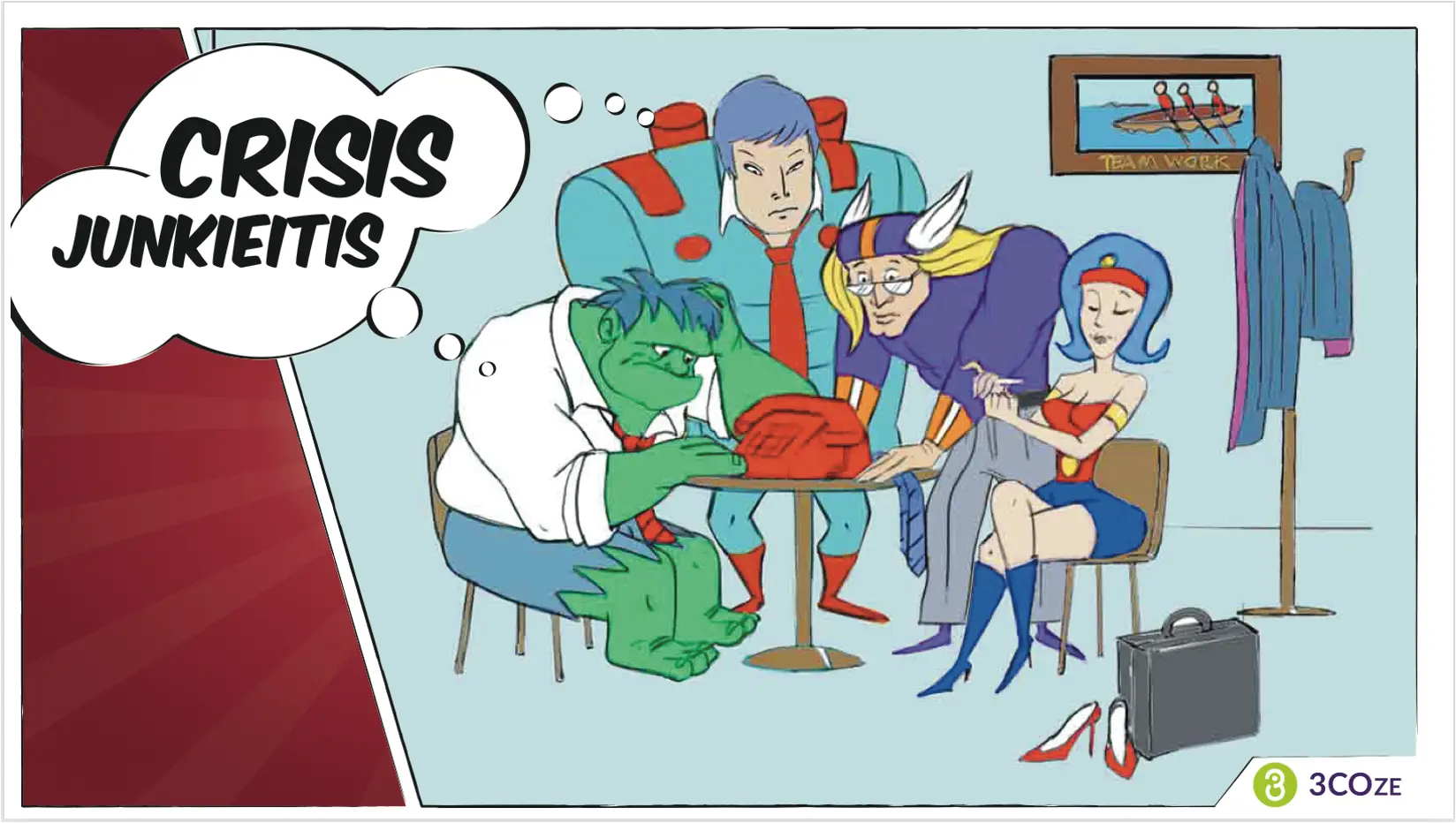
A few years later, I worked with a team at a shipping company who had just been through their own crisis: A ship had run aground off the coast of Africa and been boarded by armed pirates. At a meeting soon after the incident, I noticed people were speaking in that same tone the hospital team had used. They weren’t just debriefing about how the team had handled the crisis – they were reminiscing. This time I had to ask. “To a naive outsider, this sounds like the worst of times, not the best of times,” I said. “Help me understand why you’re talking about it this way.” The answer was simple: When the pirates attacked, everything became very clear and straightforward. The team united around one crucial priority. Everyone knew what role they would play in solving the problem. People set aside personal conflicts and political goals. Any resources needed were available immediately. The crisis had proved to them that their team could actually get things done.
Most good teams are great in a crisis – that’s not strange. But Crisis Junkie teams can only get traction when they’re fighting for survival. They lurch from crisis to crisis, only able to get work done when there’s a proverbial gun to their heads. In fact, they may even create crises to feel that sense of purpose. Why do they love the stress? Well, when the situation isn’t critical, life on one of these teams is pretty frustrating. Different team members’ roles seem to overlap, so it’s not clear who should be doing what, and they’re always stepping on each others’ toes. Priorities are unclear, either because the team leader isn’t directing the group effectively, or because there are simply too many items on the group’s to-do list, and nobody’s sure what to tackle first. It never seems like there are enough people, or dollars in the budget, to accomplish the group’s work. The team often gets bogged down in office politics or interpersonal conflicts. Fighting something (or someone) else is a welcome relief from fighting each other.
Consider the U.S. Congress. They seem to find it impossible to get much of anything done unless there’s a pressing deadline – and sometimes they even blow their deadlines. I think it’s safe to assume that nobody wants their office to look anything like the U.S. Congress. Unfortunately, many workplaces really are that dysfunctional. This kind of toxic team develops when a team lacks a cohesive identity, and when team members stop trusting each other. And once it’s gone, it can take a lot of work to reestablish that trust.
Crisis Junkies may look like heroes when they save the day, but wouldn’t it be better to manage well enough that there weren’t so many crises in the first place?
Book Me To Speak At Your Next Event
If this article is proving useful to you and you’d like to share these insights with other members of your team or organization, my talk You First is all about how you can change a toxic team from any seat at the table. Use the link below to make an inquiry:
Bobble Head Team
Have you ever looked around the room during a team meeting and realized that everyone was nodding in unison, like a bunch of bobble-head dolls? Being a part of a Bobble Head team actually feels pretty good. The mood is pleasant. The conversation is supportive and empathetic. Every idea you propose meets with enthusiastic acceptance. But nothing actually gets done. Nothing that happens in team meetings changes anything. Nice as it is, it’s a huge waste of everyone’s time.
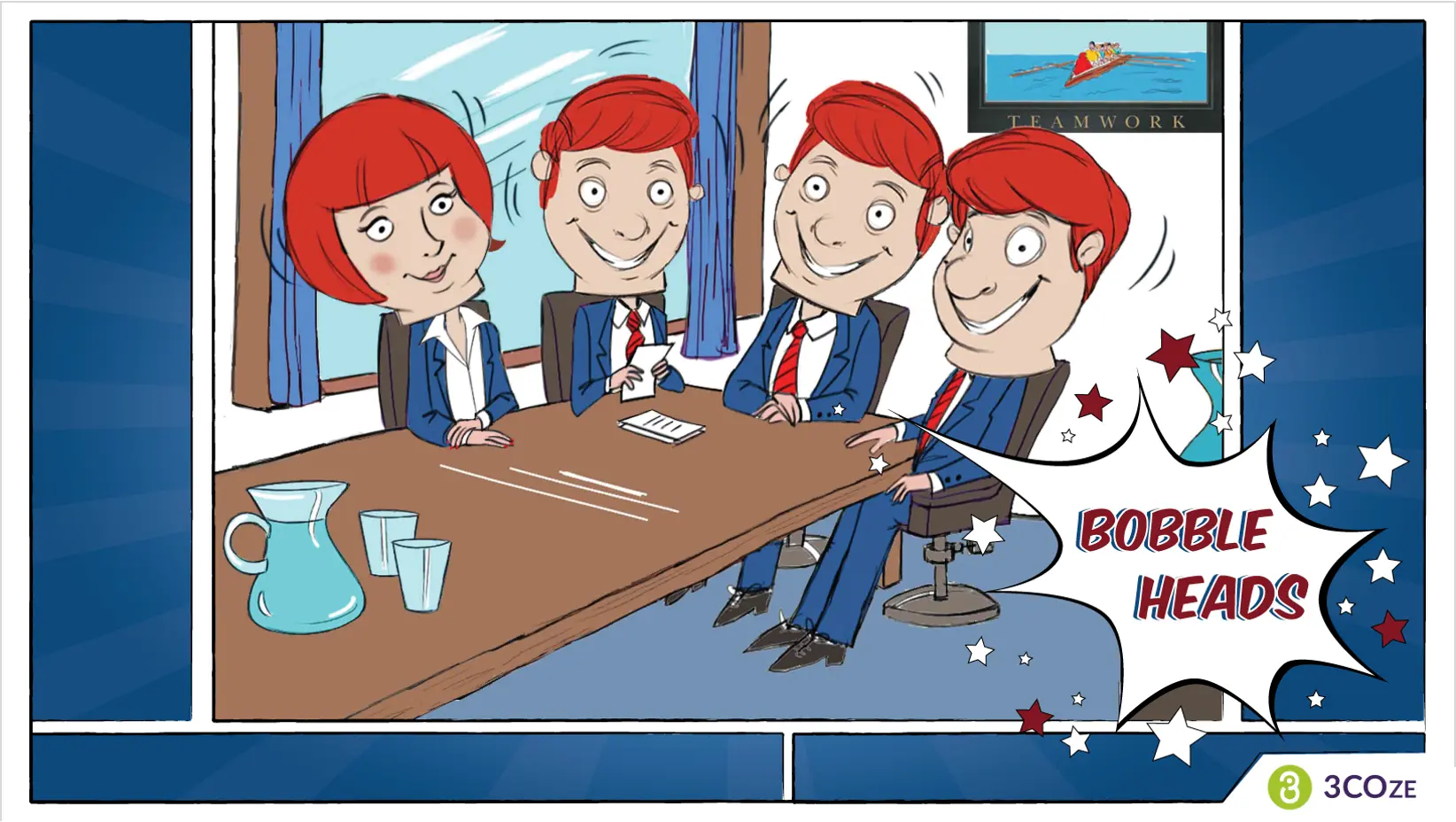
In my experience, this overly agreeable dynamic can come from a couple of different problems. In some cases, people just aren’t really listening to each other. In meetings, comments seem to drift through the room without ever really sticking in anyone’s mind. What looks like agreement is really just a bunch of people nodding mindlessly. Some turn into Bobble Head teams because there’s an uneven power dynamic in the room. All the ideas come from one or two people and everyone else is just going along with whatever these leaders say. Might as well not have a team at all.
Sometimes when a team has worked together for a while, they actually do start to agree about everything. While it may sound pleasant, this is still a dysfunctional team. In fact, it’s the most dangerous form of the Bobble Head problem. In these cases, team members’ individual styles and strengths have been lost, and groupthink has taken over. Too much group cohesiveness can make a team feel invulnerable and disconnected from the rest of the world. Groupthink makes it very difficult to identify and mitigate risk. Members of a tight-knit group may disregard the opinions of “outsiders” and automatically believe “insiders.” They may find it hard to even imagine their team making a bad decision. And they can come to enjoy the feeling of solidarity so much that they – often unconsciously – make maintaining those warm relationships with each other priority one. They’ll shoot down dissenting opinions to preserve that unanimity, and they’ll avoid making decisions that might endanger those relationships, even if that means ignoring clear signs of risk.
I’ve seen this kind of team myself. I once coached the executive team of a large organization that suffered from a similar problem. A few years ago, they had all taken the Myers-Briggs personality test. After some changes in membership, they wanted to take the test again and see how their styles had changed. The new test revealed a disturbing fact: All five people whose personality types were significantly different from the type most prevalent on the team had left the organization. Of 16 possible types, 5 of them no longer existed on this very large team. Their drive towards cohesion and agreement had actually driven out dissenting voices – and all teams need healthy dissent to succeed.
The consequences can be dire. Psychologist Irving Janis, one of the first to name and study groupthink, linked the Space Shuttle Challenger disaster and the Bay of Pigs crisis to teams suffering from this problem. In the case of the Challenger, engineers who voted “no-go” on the launch were pressured to change their minds, and some experts even self-censored to go along with the will of the group.
Observers have also argued that the decline of SwissAir – formerly known as the “Flying Bank” for its enviable financial stability – was in part a result of removing dissenting voices from the Board of Directors. The smaller, more homogeneous group ended up taking risky financial bets that brought down the company.
Get The Team You Deserve
A toxic team is just one of the many ways that team dysfunction rears its ugly head. If you want regular tips on how to banish this bothersome beast, subscribe to my monthly newsletter.
The Bleeding Back Team
This team is as passive-aggressive as the stereotypical mother-in-law. Everyone agrees while they’re in a room together, but as soon as the formal meeting is over, the resistance begins. Nothing gets implemented. People gossip, and the atmosphere gets poisoned. There’s little forward momentum. These passive-aggressive teams look pleasant enough from the outside. In fact, it’s easy to mistake this type of toxic team for Bobble Heads, because during meetings, everyone will claim to be on the same page. But talk to these team members in hushed tones at the water cooler, or behind closed doors in their offices and you’ll soon find they don’t agree about much. They fake it when they’re all in a room together, then stab each other in the back as they leave.
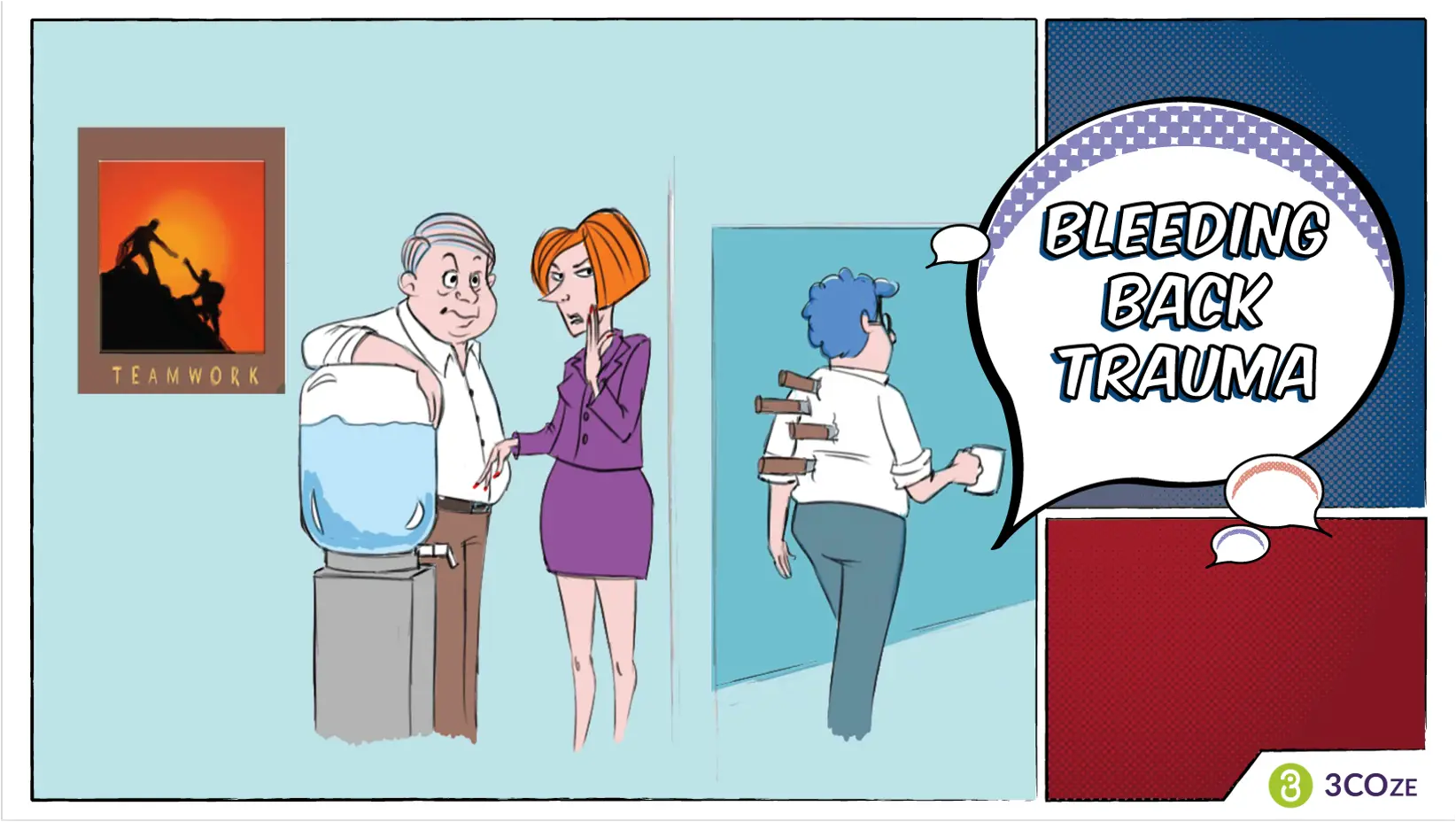
Sometimes the passive aggressive team is hard to spot. People subversively, subtly obstruct progress by rehashing decisions, reopening old discussions, or covertly resisting the implementation of the agreed plan. At its most extreme, this is one of the most difficult kinds of toxic teams to live with. The real issues never get talked about in the open. Conflict grows and grows, because people seek out like-minded colleagues outside of meetings to gossip and gripe with. They reinforce each others’ views and become less and less able to see the other side of the problem.
Like the Crisis Junkies, this type of toxic team tends to suffer from a serious lack of trust. They can’t even trust what people have said on the record in meetings. Passive-aggressive people will verbally express agreement with a plan and then either do the opposite of what they agreed to do, execute the plan too slowly to meet the goal, or otherwise undermine their colleagues.
I get enough of passive aggressive teams during the day so I’ve given up on reality shows because passive aggressive behavior is so prevalent. Survivor, Project Runway, The Apprentice, all highlight the cost of this team disease. As soon as one team member comes up with a plan, the others tell her they love her ideas – and spend the next two days talking behind her back about how badly things are going to turn out. With so much energy directed at complaining instead of executing, the plan is doomed to fail. Sure enough, when the team debriefs in front of the judges (or the secret cameras), out come the knives – even though they never tried to address the issue before it was too late.
No matter what the task, this type of team can be particularly hard on a team leader, because often everyone is focusing their bad feelings on him, without ever openly acknowledging what’s bothering them. He’s the target for a lot of negativity, but he never gets a chance to address it.
A professional services team I worked with provides a great example of this type of team. In this case, one prominent member of the team didn’t like the direction that the team leader was taking the business. But rather than express that directly, she quietly went around to other members of the team telling them that they would be sidelined by the new strategy – that they would never have a chance to do great work in the new model. Slowly, a truly toxic situation built up with members of the team feeling that the boss was out to get them. But it was an insidious problem because the team leader had no direct information about the issues – and in the time that it took to uncover this covert conspiracy theory, serious damage had been done. It was tragic for all involved – for the people who were needlessly concerned about their careers – and for the team leader who became a pariah without knowing there was a problem. In these types of teams, resistance burns like a deadly root fire, it gains momentum under the surface.
Regardless of who’s the target of the gossip, this kind of passive-aggressive behavior creates a vicious cycle that’s very hard to break out of. And wouldn’t we all prefer open, healthy, productive conflict?
How to Tell if You’re in a Toxic Work Environment
Toxicity comes in many different varieties. It may very well be that your team is toxic, but the problem could coming from somewhere else in your organization too. This video should give you a clearer idea of where the dysfunction is truly coming from, and once you know, what to do about it.
The Spectator Team
More and more tech companies these days are making team members stand during meetings, according to a Wall Street Journal article. One organization even makes everyone who speaks hold a 10-pound medicine ball. The goal is to keep meetings short and efficient – and that’s certainly a worthwhile goal. But in some cases, inefficient meetings are a symptom of a deeper problem.
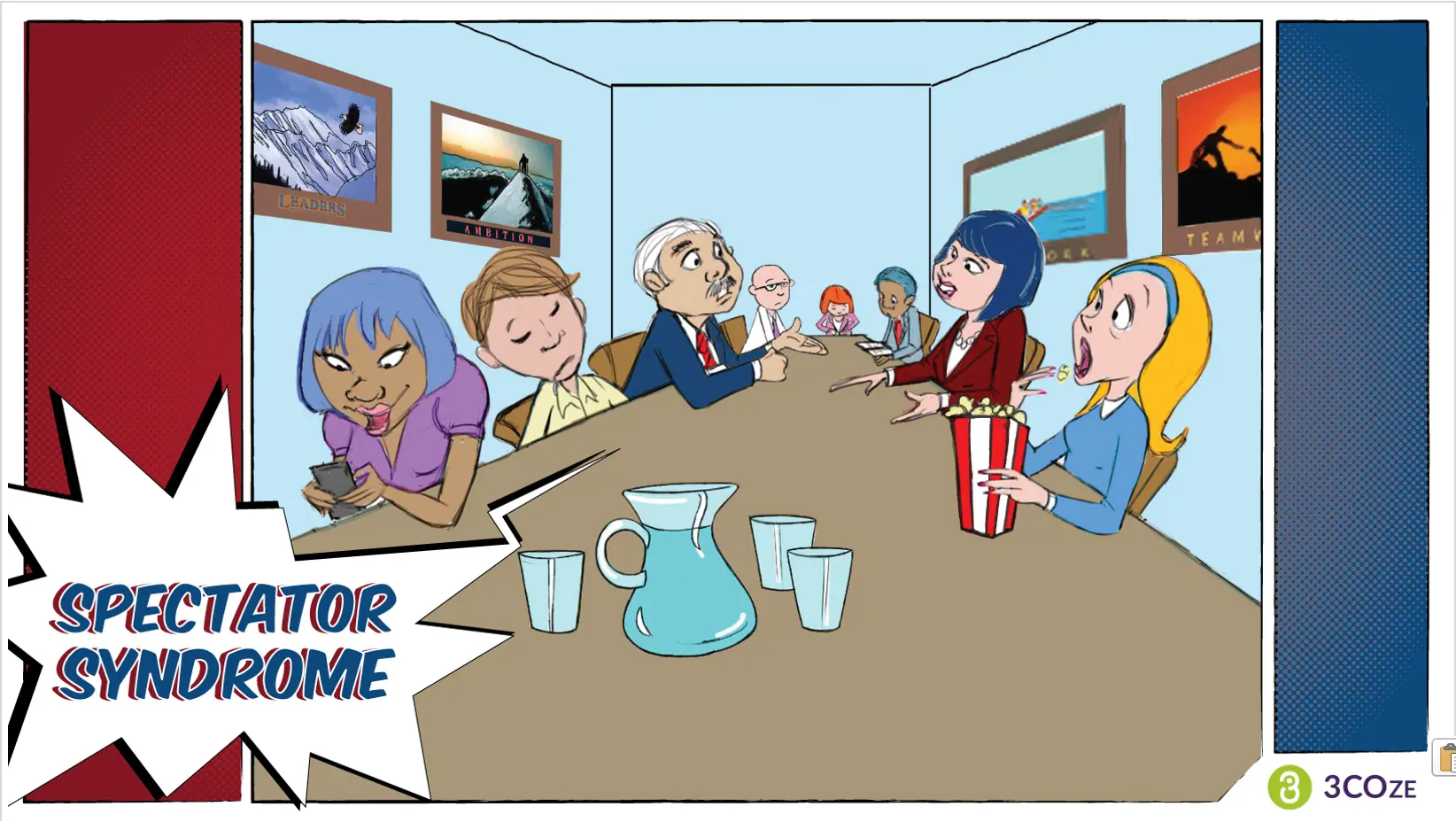
Like the Bleeding Back Team, the Spectator Team might appear to be getting lots done. Meeting agendas are packed with important items to discuss. But if you’re in one of those meetings, it doesn’t feel productive. It feels like you’ve got a front-row seat at Wimbledon. Two people are talking, and the rest of you have been turned into spectators.
Unfortunately, this dynamic is often the team leader’s fault. She’s essentially having a series of one-on-one meetings while everyone’s in the room. She questions one team member for a while and then turns to the next. It’s convenient for the boss, but it’s a waste of everyone else’s time. It feels like being in grade school again and listening to the rest of the class present their book reports – for books you haven’t read. If you’re in one of these meetings, you may find yourself zoning out, worrying about your long to-do list, or simply wondering why you have to be there at all.
I worked with one executive team where this spectator problem was particularly pronounced. The leader of the team – the CEO – was kind of an efficiency nut. Unfortunately, he was only thinking about efficiency from his own perspective. He was so focused on what he called “running a tight ship” that each agenda item got just 10 minutes. Not only did the CEO spend those 10-minute time slots going back and forth with one team member at a time, when someone else would jump in with a question or a comment, the CEO would tell them to “take it offline.” Even the biggest project they were engaged in at the time, implementing an enterprise software system, got those same 10 minutes, with only two people talking.
I sat in on one meeting where, well into the two-hour agenda, there was a 10-minute slot labeled “Create a Performance Culture.” This CEO’s approach made it all too clear to the rest of his team that they weren’t really expected to add value to these meetings. They were perfectly free to zone out while their colleagues were talking. In fact, they were pretty much required to. All their boss wanted them to do was to wait for their turn to talk.
A spectator dynamic can also come out of strong tension between two members of the team. Perhaps for personal reasons, they just can’t agree on anything. When one says “black,” the other always says “white.” Naturally, this constant tension makes the rest of the team uncomfortable. And the fact that these two people end up fighting over every single issue, no matter how trivial, means meetings get bogged down in their conflict. Eventually, the rest of the team disengages. They stop trying to contribute or steer the conversation in a more productive direction, and they turn into spectators.
ADDITIONAL RESOURCES
If you’re finding these insights into your team’s dysfunction useful, here are some additional resources from the blog:
The Royal Rumble Team
If you’re an adrenaline junkie with a high tolerance for pain, this is the team for you. Voices are raised. Names are called, and the conversation tends to get personal. Sure, some people might prefer this type of outright aggression to the buried conflict of a passive-aggressive team. Some people prefer to be stabbed in the front than in the back. But wouldn’t most of us prefer not to be stabbed at all?
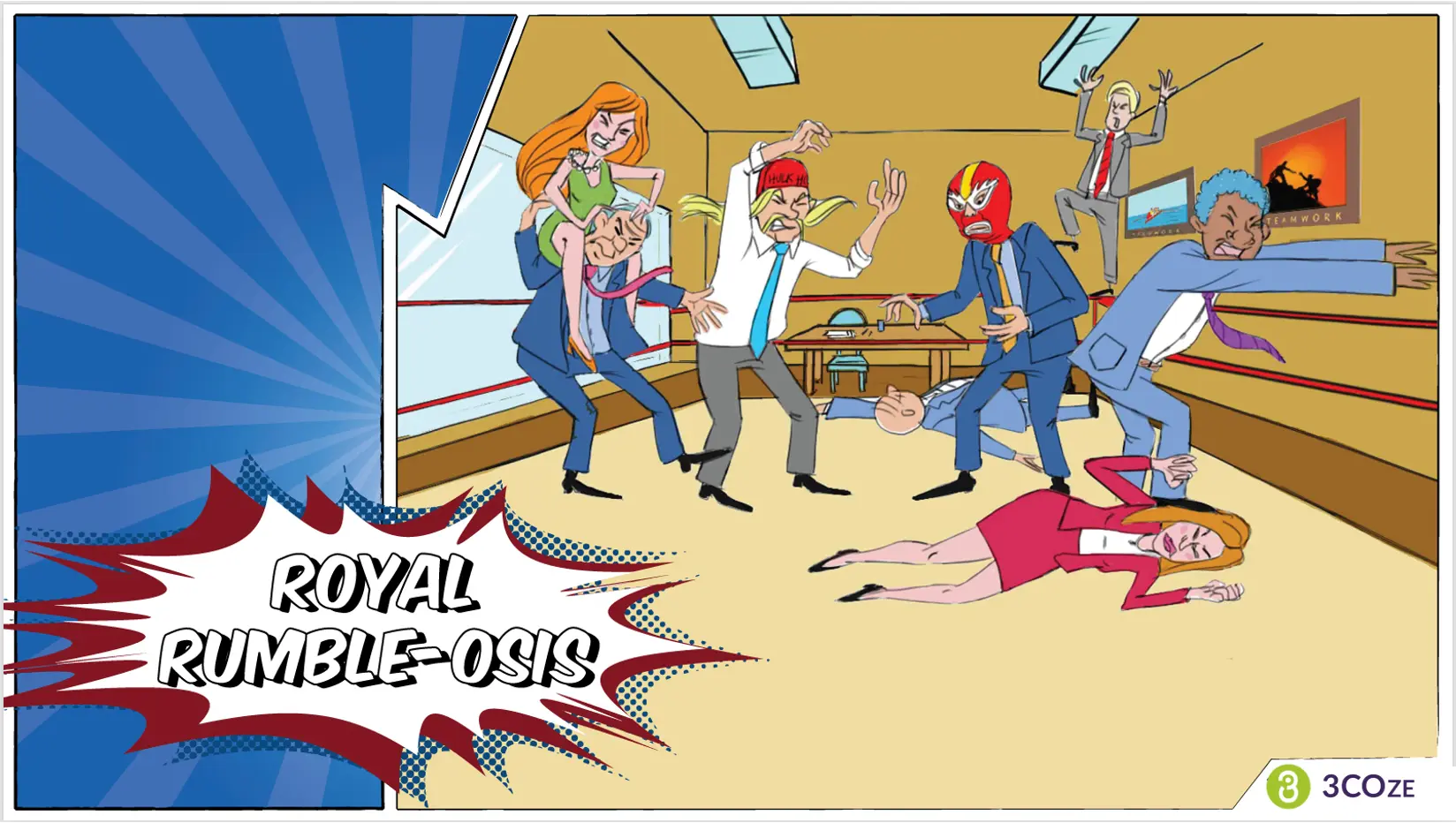
As a team effectiveness expert, I actually spend a lot of time trying to nurture conflicts in the board room. But I’m looking for productive conflict that’s focused on issues, not individuals. How do I tell the difference? Unhealthy conflict sounds different. The word “you” gets used a lot – as in “you didn’t,” or “you should.” People talk a lot about the past – about “last time,” or what “never” or “always” happens. The conversation gets loud. People’s tones become more aggressive. People with louder, deeper voices start asserting themselves over the rest of the team. Some people display aggressive body language – leaning in and pounding on the table – while others start to look defensive – leaning back, folding their arms, avoiding eye contact.
Unfortunately, sometimes it only takes a couple of bad interactions to turn a team toxic. Robert Sutton, a professor of management at Stanford University, has written that destructive behavior like disrespect for others can be contagious. In part, that’s because people tend to remember negative interactions more than positive ones – I might forget the three pleasant chats I had with coworkers on Monday, but one hostile encounter will ruin my day. And, like other forms of team toxicity, an overly aggressive atmosphere can hurt the bottom line by making everyone on the team more stressed and less productive.
A survey of workers in Australia and New Zealand found that people who felt their colleagues were rude to them – interrupting them, insulting them, or putting down their ideas – ended up less committed to their jobs, less willing to take on extra work, and more likely to leave the company.
I worked with the ultimate Royal Rumble Team out in Silicon Valley. These were the quintessential Silicon Valley guys. They were very, very smart. They had come to the Valley because they cared about being on the cutting edge and they wanted to invent something new. Their lives were devoted to the product they were building. They stayed up late every night, drinking and talking about technology. They had Diet Coke for breakfast. They came into meetings with a lot of energy. And they’d engage with each other in an aggressive way that they thought was all part of the game – until it was aimed at them, of course.
This toxic atmosphere actually developed out of one of the team’s greatest strengths – their passion. They all wanted to succeed. They all cared deeply about the company – so deeply that they let conflicts get personal. Ultimately those conflicts hurt their performance. Because of this team’s dysfunction, the competition kept moving while they fought internally about which projects to do and which ones to kill.
No matter where this type of dysfunction happens, anyone in a team like this ends up being driven by his amygdala, the primitive part of the brain that processes emotions and controls aggression and fear. Someone in this state isn’t really thinking or hearing what colleagues are really saying. He’s reacting on instinct. And unfortunately, because stimulating the amygdala makes people form sharper memories, every fight the team has is etched in his brain. As soon as someone starts talking, his stress level starts rising, because he remembers the other times that person has attacked or belittled his ideas. He reacts defensively to his comments, and a vicious cycle begins.
Dissent and disagreement can be good for team performance. After all, too much agreement can lead to groupthink. But Royal Rumble teams can’t build much of anything together because they’re too busy tearing each other down. Their conflict is too personal and too focused on old wounds.
Still Worried About Your Toxic Team?
It’s not only poor team dynamics that can make you feel like you’re in a toxic work environment. Check out the four other definitions of a toxic work environment here, along with a bunch of other ideas to help you navigate the kinds of work environments that are harmful to your wellbeing.
You in a Team
You know that old cliché that there is “no I in team.” I get the sentiment, but the idea is too simple. I like to say that there is a “You in team.” If you’re on a toxic team, you’re either the one who’s been wounding other people, you’re the one who allowed yourself to be wounded – or you’re the one who stood by and watched. You’ve probably been each of these at some point.
But I’ve also got good news. Even the worst toxic team can be fixed. (As proof in the pudding, that team that needed the rabies shot is now a high performing team.) And you can get that change started, whether you’re the leader of the team or not. If you change your behavior – if you start focusing on issues instead of personalities, if you try to make sure everyone’s voice gets heard, if you speak up publicly when you don’t like the direction things are going – you can start to detoxify your team.
Chances are good that if you take a first step toward making your work atmosphere more productive, you’ll find allies. Years ago, people used to react in horror to the idea of working in a team. It seemed to send them back to group projects in school, where they ended up having to do all the work while the slacker kids sat back and watched. If they didn’t step up, they risked getting a bad grade. As a result, many people grew up thinking of teamwork as a threat to success instead of a way to ensure it.
But these days we’re seeing more signs that people are embracing teamwork. One recent survey of thousands of employees found that people expressed appreciation for their coworkers even more often than they expressed a desire for a raise. In another study, 89% of employees said they’d rather participate in team-building activities than get an extra day off of work.
A healthy and vital team is a goal worth striving for. There may be conflict, but if it ever gets personal, team members catch themselves, apologize, and go back to talking about the issues. People have more productive conflict because they have the trust to engage directly with one another. They have more opportunity to develop their skills and get things done, because they’re spending less time and energy dealing with office politics. A healthy team can make each of its members more successful by combining their complementary skills. Even when things get tough, a healthy team gives us a community of people to share the workload with, and to diffuse the stress.
More and more of our work is being done in teams. Too much to put up with toxic behavior. We’ve got to do better.
How Can I Manage My Bad Boss?
Here’s some advice for how to speak truth to power in any situation. Sticking to these rules can make it much harder for your toxic boss to unleash on you.
Catalog of Toxic Bosses
If you’ve got this far and you don’t see your team dysfunction on display, it may not be your team that’s toxic at all – it might be your boss. Here’s my current catalog of craptacular bosses with specific advice about how to manage each one. Scroll through the catalog. If you don’t see your brand of toxic boss here, send me a note, I’ll create a new entry in the catalog just for you!
More Toxic Workplace Resources
[1] Building a psychologically safe workplace – Amy Edmondson | TEDxHGSE
[2] Time’s Up for Toxic Workplaces – Manuela Priesemuth | HBR
[3] Toxic Culture Is Driving the Great Resignation – Donald Sull, Charles Sull, and Ben Zweig | MIT Sloan Management Review
[4] How to Tell If a Prospective Workplace Is Toxic – Mita Mallick | HBR
[5] On a Terrible Team? Maybe You’re Making It Worse – Liane Davey | HBR








